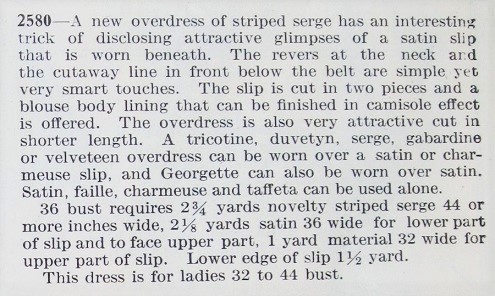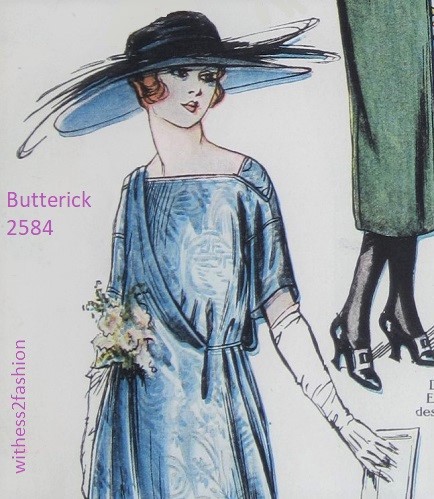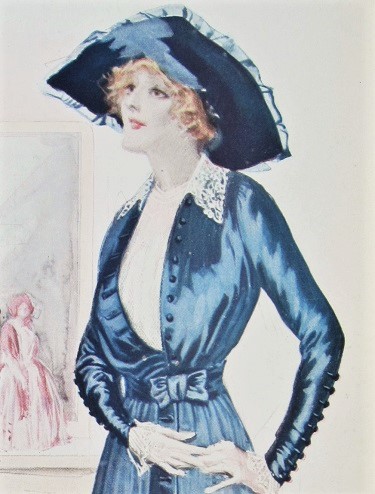When I named this blog “witness2fashion,” it didn’t occur to me that its initials were WTF. However, that abbreviation does occur to me occasionally when I’m wandering through the pages of a 100 year old magazine.
Caution: this ad uses a word that is offensive when applied to a human being, but the ad uses it to describe a sock supporter….

Ad for “Velvet-Grip Baby Midget Hose Supporters,” Delineator, February 1920.
What the hey? “Baby Midgets” are tiny garters or stocking suspenders which are attached to this baby’s diaper with safety pins!

Seriously: How is a garter supposed to hold up your stockings when you can’t even stand up and walk yet?
I remember reading a book (The Egg and I?) in which the grandmother, hearing that the children were either making too much noise or were suspiciously silent, would shout, “You! Pull up your socks!” This was a fairly effective all-purpose command, since children couldn’t pull up their socks without removing a hand from the cookie jar, or putting down that air rifle…. Just today, reading The Library Book, by Susan Orlean, I found that the Oklahoma Public library sent a condolence message to the Los Angeles Library after a terrible fire. It included the encouraging (?) phrase, “Keep your socks up!”
Incidentally, I also found this ad for Baby Dimples Safety Pins. Awwwww….

Ad for Baby Dimples Safety Pins, Delineator, January 1920.
Here’s another old expression: “Keep it under your hat.”

Paris hat designed by Virot, Delineator, March 1912.
Don’t wear it while driving. Or while crossing a busy street.
Speaking of hats….

Hat featured in an ad for Cheney “Shower-Proof” silks. Delineator, March 1912.

Ad for Cheney “Shower-Proof” Silks, March 1912.
I don’t know why she would need an umbrella when she’s wearing that hat! In fact, I’m not sure the umbrella would be big enough to cover that hat. (And what about the umbrella handle…? She couldn’t get it close to her head… or even close to her shoulder! Which is why the umbrella is down on the ground catching water, I guess.)
I started with the intention of writing about this:

When is this? (No, not 2012….)
It surprised me. It’s got bare shoulders. It’s got breast exposure. It’s got a good chance of a “wardrobe malfunction” if you lean sideways. I could imagine this on the red carpet of some awards show, probably in red satin, and probably held in place with toupee tape.
(“Toupee tape” was for many years as common in a wardrobe person’s tool kit as safety pins. It was a double-sided tape intended to secure a toupee to a bald head, but was quickly adapted to keeping low-cut dresses from gaping too far for television. Its great virtue was that the adhesive didn’t give out when exposed to sweat or body oils. Now there’s a similar product manufactured and sold — in larger quantities — specifically for use with clothing.) The video ad amusingly says it prevents “peekaboob.”)

I found this sketch charming. Clue to the date: the artist is fashion illustrator Soulié. [The model was not a young Nicole Kidman….]
And this bodice is part of a couture dress designed by Jeanne Lanvin and shown in Paris in 1920.

Couture gown by Jeanne Lanvin, Paris, 1920. The net skirt is embroidered and beaded. Sketched for Delineator, March 1920.

A deep V neckline in 1920? Breasts as an erogenous zone in 1920? Yes, to my surprise…

Couture gown by Martial et Armand, Paris, 1920.
When I showed these images to a non-fashion-historian friend, she couldn’t get over the “make-your-hips-look-at-least twice-as-wide” skirts.

Couture evening gown by Martial et Armand, sketched for Delineator, January 1920.
The bottom of the hip yoke is wired to make the skirt stand away from the body.  Of course, the coat to wear over a dress like this will not produce a slender silhouette, either:
Of course, the coat to wear over a dress like this will not produce a slender silhouette, either:

An “evening cloak” and gown designed by Bulloz, Paris, 1920.
My friend was also horrified by the long, dragging panels on these dresses. (Fashion historians accept that wasteful, extravagant, impractical “conspicuous consumption” is a hallmark of high fashion.) “How could you dance in a dress like this?” we wondered. “Everybody would step on it! It would get so dirty!”
The editors of Delineator had a suggestion:
 So that’s what you do with it…. Or them…. This gown has two dragging “French panels,” one of fragile lace and one of silk:
So that’s what you do with it…. Or them…. This gown has two dragging “French panels,” one of fragile lace and one of silk:

Couture gown by designer Elise Poret [not Poiret] from the February, 1920 Delineator.
(That dress also has an “oriental hem.”) There have been many decades when skirts were widened to make waists look smaller by comparison. But that’s not what’s happening here.

We are so conditioned to the fashion ideal of slenderness (or at least, a tall, lean look on fashion models) that, while I was thinking,”Wow! a bodice held up by straps in 1920!” my friend was asking “Why would you wear that? It makes her look fat!”
I look at this hip-widening gown by Berthe and notice that its couture workmanship is outstanding, and … pretty:

Couture gown by Berthe-Hermance illustrated in May, 1920; Delineator.

Couture details on a 1920 gown. Undeniably luxurious.
(Also undeniable is its potential for a wardrobe malfunction if one shoulder relaxes….)
But it is difficult for me to look at coats like these and yearn to wear them:

Evening coats from Butterick patterns, November 1920.

Couture “cloak” by Renee, covered with red, yellow, and green “balls.” January 1920.

“What The F[ashion]?” Are those mules on her feet? With a coat? Seriously? And, what did it feel like to sit on those balls?
The historic House of Worth contributed this (shall we say transitional?) suit which gets its stiffness from pony skin.
[Perfect if your name is “Whinnie.”]

From the House of Worth, Paris. Illustrated in Delineator, January 1920.

In other words, after five years of war and its aftermath, Paris went mad for luxury. “Suits no longer content themselves with fur collar and cuffs but are made entirely of mole, caracul, etc.” A lot of horses died in WW I, so I guess pony was a luxury item, too.
To end on a more cheerful note, we know about harem skirts and orientalism and the influence of the Ballet Russe. But this is the first photo of a model wearing harem pants that I’ve encountered:

Orientalism in high fashion: a harem hem for an evening in Paris. Delineator, May 1920.
Glamourdaze paid tribute to the Poiret-influenced harem hem outfit worn on Downton Abbey. But these are later, and not by Poiret.

Information about “Deddy” is hard to find, but the designer Deddy did appear in Delineator fashion coverage more than once.
The harem pants worn on Downton Abbey by Lady Sybil were definitely not as revealing as this outfit!

Very Bare in 1920: The top of Deddy’s harem outfit.
That’s all my “WTFashion?” images for now. More to come.
























































































































































 Of course, the coat to wear over a dress like this will not produce a slender silhouette, either:
Of course, the coat to wear over a dress like this will not produce a slender silhouette, either:
 So that’s what you do with it…. Or them…. This gown has two dragging “French panels,” one of fragile lace and one of silk:
So that’s what you do with it…. Or them…. This gown has two dragging “French panels,” one of fragile lace and one of silk:

























